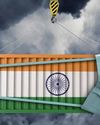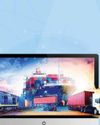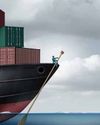CMA CGM A Strategy Makeover
Maritime Gateway
|November 2017
In the spring of 2017, when Rodolphe SAADE the new Chief Executive Officer of CMA CGM Group walked in to his Mumbai office , he set a strategic course with four priorities for the group. It was every country head’s mandate to ship for the future. With abundant zeal, a fool proof plan and an ambitious team, Audrey Dolhen and her agency are making India future ready for her ship.

Given that 90 per cent of the world’s trade moves by sea, shipping lines are by far one of the oldest industry houses globally. And so, for corporations that have been in trade for many decades, being conservative is a natural trait. Change comes slowly.
However, many a line today, led by the bigger ones are making waves in international and inter regional trade by taking big strides offering more services in other segments as a natural extension to their main line businesses. Slowly, but surely, carriers such as CMA CGM are moving with considered aggression to expand their products and services inland much as they introduce new ports of call to different destinations.
What do you think prompted this change? Several factors. For quite a few years after the financial blitzkrieg in 2008, shipping lines tried to stay afloat by cutting costs and capacity, attempting slow steaming and reworking their routes. Despite making these amends, the trade’s recovery was spotty because every attempt from the carriers’ side was met with redoubled efforts by corporate customers to control costs. With consolidation amongst liners from all over and of all sizes, most lines ran out of premium products and differentiating services. So, clearly, market economics is one reason to move shoreward. The second influencing factor is government policy. With many neo economic powers such as India and China focussing on improving their global logistics index and rank in the ease of doing business chart, policies such as Direct Port Delivery and Goods and Services Tax have impelled lines to consider the curious case of investing greatly in inland services. Lastly, but most significantly, the Big C has been the biggest harbinger of change. Changing needs of the customers has prompted CMA CGM among others to plunge in to making the first and last mile connectivity as seamless as the main leg.
このストーリーは、Maritime Gateway の November 2017 版からのものです。
Magzter GOLD を購読すると、厳選された何千ものプレミアム記事や、10,000 以上の雑誌や新聞にアクセスできます。
すでに購読者ですか? サインイン
Maritime Gateway からのその他のストーリー

Maritime Gateway
Impact Of Covid-19 On Shipping And Logistics
Industry stalwarts discuss threadbare the prevailing logistics and supply chain scenario and issues in clearing cargo during the COVID-19 lockdown
15 mins
May 2020

Maritime Gateway
Digital Platforms Defy Lockdown
Digital trading modules such as eNAM are enabling farmers to move their produce from farm to market even during the lockdown
4 mins
May 2020

Maritime Gateway
GARMENT TRADE TRAMPLED
As retailers face a shutdown in US and Europe, the cascading affect has caused mass cancellation of orders in Bangladesh
2 mins
May 2020

Maritime Gateway
TRADE RESUMES WITH CHINA
While India has allowed uninterrupted movement of imports into Nepal even during lockdown, China is reopening its borders as it emerges from the pandemic
2 mins
May 2020
Maritime Gateway
LESS HUMAN INTENSIVE, MORE DATA DRIVEN
AI provides transformational opportunity for logistics industry by improving customer experience, operational efficiency, faster turnaround time and lower cost while ensuring security and transparency. Macro environment requires industry to transform to be less human intensive, agile and data driven, all of which can be accelerated by AI adoption, shares Gangadhar Gude, Founder & CEO, atai.ai
6 mins
May 2020

Maritime Gateway
SHAKEN AND STIRRED
The COVID-19 pandemic has partially paralysed the logistics and supply chain, but the industry is still deterred to ensure supply of essentials continues
9 mins
May 2020

Maritime Gateway
TRADE STUCK, ECONOMY SLOWS DOWN
Sri Lankan economy slows down as trade deficit widens and supply chain disrupts amidst lockdown
2 mins
May 2020

Maritime Gateway
LENDING INTELLIGENCE TO SUPPLY CHAIN
If you’re shipping millions of dollars’ worth of pharmaceuticals, high-end electronics, expensive seafood, or precious metals, what would you be willing to pay for the ability to ‘ask’ your shipment where it is right now and whether it’s ok? What would you pay for a freight smart enough to raise an alarm before it spoils? Artificial Intelligence enables that and much more…
15 mins
May 2020

Maritime Gateway
CONTAINER LINES SIGNAL ‘SOS'
As the per-unit cost of operations increases many lines are forced to blank sailings which has hit their bottom line real hard. The Government and Terminal Operators therefore need to actively consider reduction in Vessel Related Costs
2 mins
May 2020

Maritime Gateway
IMO 2020 And The Covid-19 Curse
The COVID-19 outbreak has shaken and stirred the already volatile bunker market. While the refiners adjust their capacities and shipping lines choose their path to compliance, the market dynamics are yet to reach an equilibrium
12 mins
April 2020
Translate
Change font size

